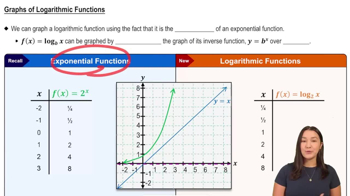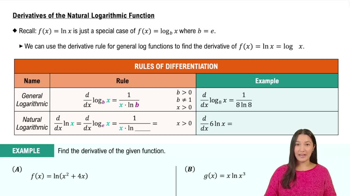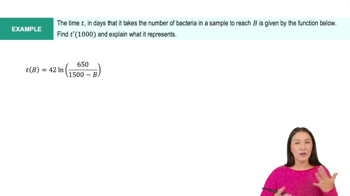Table of contents
- 0. Functions7h 52m
- Introduction to Functions16m
- Piecewise Functions10m
- Properties of Functions9m
- Common Functions1h 8m
- Transformations5m
- Combining Functions27m
- Exponent rules32m
- Exponential Functions28m
- Logarithmic Functions24m
- Properties of Logarithms34m
- Exponential & Logarithmic Equations35m
- Introduction to Trigonometric Functions38m
- Graphs of Trigonometric Functions44m
- Trigonometric Identities47m
- Inverse Trigonometric Functions48m
- 1. Limits and Continuity2h 2m
- 2. Intro to Derivatives1h 33m
- 3. Techniques of Differentiation3h 18m
- 4. Applications of Derivatives2h 38m
- 5. Graphical Applications of Derivatives6h 2m
- 6. Derivatives of Inverse, Exponential, & Logarithmic Functions2h 37m
- 7. Antiderivatives & Indefinite Integrals1h 26m
- 8. Definite Integrals4h 44m
- 9. Graphical Applications of Integrals2h 27m
- 10. Physics Applications of Integrals 2h 22m
6. Derivatives of Inverse, Exponential, & Logarithmic Functions
Derivatives of Exponential & Logarithmic Functions
Problem 3.9.63
Textbook Question
Calculate the derivative of the following functions. In some cases, it is useful to use the properties of logarithms to simplify the functions before computing f'(x).
y = 4 log₃(x²−1)
 Verified step by step guidance
Verified step by step guidance1
First, recognize that the function y = 4 log₃(x²−1) can be simplified using the change of base formula for logarithms. The change of base formula is logₐ(b) = ln(b) / ln(a). Therefore, rewrite the function as y = 4 * (ln(x²−1) / ln(3)).
Next, apply the constant multiple rule of differentiation. The derivative of a constant times a function is the constant times the derivative of the function. So, differentiate y = 4 * (ln(x²−1) / ln(3)) with respect to x.
Now, focus on differentiating the natural logarithm part, ln(x²−1). Use the chain rule, which states that the derivative of ln(u) is (1/u) * (du/dx). Here, u = x²−1, so find the derivative of u with respect to x, which is du/dx = 2x.
Substitute the derivative of u back into the chain rule formula. The derivative of ln(x²−1) is (1/(x²−1)) * 2x.
Finally, combine all the parts. The derivative of y = 4 * (ln(x²−1) / ln(3)) is (4/ln(3)) * (2x/(x²−1)). Simplify the expression if necessary.
 Verified video answer for a similar problem:
Verified video answer for a similar problem:This video solution was recommended by our tutors as helpful for the problem above
Video duration:
5mPlay a video:
Was this helpful?
Key Concepts
Here are the essential concepts you must grasp in order to answer the question correctly.
Derivative
The derivative of a function measures how the function's output value changes as its input value changes. It is a fundamental concept in calculus, representing the slope of the tangent line to the curve at any given point. The derivative is denoted as f'(x) or dy/dx and can be calculated using various rules, such as the power rule, product rule, and chain rule.
Recommended video:

Derivatives
Logarithmic Functions
Logarithmic functions are the inverses of exponential functions and are used to simplify complex expressions, especially when dealing with products or powers. The properties of logarithms, such as the product, quotient, and power rules, allow us to rewrite logarithmic expressions in a more manageable form. For example, logₐ(bc) = logₐ(b) + logₐ(c) helps in breaking down the function before differentiation.
Recommended video:

Graphs of Logarithmic Functions
Change of Base Formula
The change of base formula allows us to convert logarithms from one base to another, which can be particularly useful in calculus. For instance, logₐ(b) can be expressed as logₓ(b) / logₓ(a) for any positive x. This is helpful when differentiating logarithmic functions with bases other than e or 10, as it enables the use of natural logarithms, which have simpler derivatives.
Recommended video:

Change of Base Property

 4:50m
4:50mWatch next
Master Derivatives of General Exponential Functions with a bite sized video explanation from Callie
Start learningRelated Videos
Related Practice














